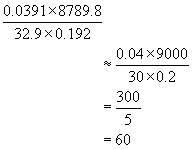Home >> Number - Approximation
[ rounding to decimal places ][ rounding to tens, hundreds etc. ]
[ rounding to significant figures ][ estimates ][ bounds ]
Rounding to a required number of decimal places
The key is to look at the number after the required number of decimal places.
e.g. write 7.7186 to 3 decimal places(d.p.)
The 6 is what is called the 'decider'.
If this number is '5' or more, then the 3rd decimal is 'rounded up'.
Less than '5' and the decimal stays the same.
In this example 5.7186 becomes 5.719
The '8' is rounded up to '9', because '6' is 5 or more.
Examples
|
19.17 to 1 d.p. is 19.2
0.0214 to 2 d.p. is 0.02
34.4255 to 3 d.p. is 34.426
|
Rounding to tens, hundreds, thousands etc.
Examples
|
24,214 to the nearest thousand is 24,000
24,214 to the nearest hundred is 24,200
35,712 to the nearest thousand is 36,000
35,712 to the nearest hundred is 35700
795 to the nearest hundred is 800
56 to the nearest ten is 60 |
Rounding to a number of significant figures
The required number is found by ignoring any zeros infront or behind the line of numerals and rounding where needed.
Example #1
0.001292 ................to 3 significant figures
the three figures are 1 2 9
answer = 0.00129
Example #2
120,101 ................to 4 significant figures
the four figures are 1201
answer = 120,100
Example #3
13.27 ................to 3 significant figures
the 13.272 rounds up to 13.3
the three figures are 133
answer = 13.3
Estimates - An estimate is a rough approximation, usually of a calculation.
The rule is to round to one significant figure.
Example #1

Example #2

Upper & lower Bounds
The use of 'bounds' is a practical mathematical method quite different from 'decimal rounding'. Do not confuse the two. Decimal rounding depends on a '5 or more' being rounded up. Bounds is quite different.
Whenever measurements are expressed in the real world they are often given an upper bound(highest value) and a lower bound(lower value).
Example #1 - A length of wood is 1500 mm long, correct to the nearest 'm.m.'.
The upper bound is therefore: 1500.5 m.m.
The lower bound is therefore: 1499.5 m.m.
Note - The upper & lower bounds are HALF the degree of accuracy.
In our example, ![]() m.m., that is half of 1 m.m.
m.m., that is half of 1 m.m.
Example #2 - A poster measures 99.5 cm x 192.2 cm correct to the nearest 0.1 cm.
Find the upper and lower bounds for the poster's dimensions, hence find its maximum & minimum area.( to 2 d.p.)
upper bounds 99.55 , and 192.25................lower bounds 99.45 , 192.15
maximum area = 99.55 x 192.25 = 19138.488 = 19138.49 (2d.p.) sq. c.m.
minimum area = 99.45 x 192.15 = 19109.318 = 19109.32 (2 d.p.)sq. c.m.
Example #2 - A rocket travels a vertical distance of 50k.m.(correct to nearest k.m.) in 23.1 seconds(correct to the nearest 0.1 second.
What are the upper and lower limits to the rocket's average speed?
upper bounds 50.5k.m. , and 23.15 sec...........lower bounds 49.5k.m. , 23.05
![]()
The highest average speed is with the largest distance divided by the smallest time.


[ About ] [ FAQ ] [ Links ] [ Terms & Conditions ] [ Privacy ] [ Site Map ] [ Contact ]
